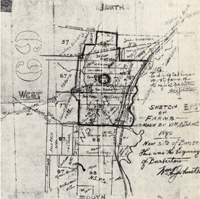Founded in 1891, the city of Barberton has enjoyed more than a century of history along the banks of the  Tuscarawas River. At the time of Barberton’s founding, the area was little more than farmland and a few scattered houses. Prior to the arrival of settlers, the area had been a thoroughfare for Native Americans who established camps along portage paths between the Cuyahoga and Tuscarawas Rivers. Growing numbers of settlers eventually forced native peoples out of the area and in 1817 the village of New Portage was established, located where north Barberton lies today. Though this village eventually failed, New Portage was resettled further downriver where it stood when O.C. Barber first laid plans for Barberton.
Tuscarawas River. At the time of Barberton’s founding, the area was little more than farmland and a few scattered houses. Prior to the arrival of settlers, the area had been a thoroughfare for Native Americans who established camps along portage paths between the Cuyahoga and Tuscarawas Rivers. Growing numbers of settlers eventually forced native peoples out of the area and in 1817 the village of New Portage was established, located where north Barberton lies today. Though this village eventually failed, New Portage was resettled further downriver where it stood when O.C. Barber first laid plans for Barberton.
 O.C. Barber recognized the area’s prime location and potential for growth, situated along two important railroad lines and the Ohio Canal. Barber and his associates began planning the layout of the town, hiring surveyor William A. Johnston to plot the streets and business districts that would become home to numerous businesses and factories through the years. The downtown area was designed around Lake Anna, a 10-acre spring-fed glacial lake in the center of town named for Barber’s daughter, Anna Laura Barber. Despite a brief economic lag in the 1890s, Barberton quickly grew, so fast in fact that it earned the nickname the “Magic City,” a nickname that remains to this day. The first part of the twentieth century proved a time of great expansion and growth as the population of the city grew from 1,800 in 1892 to nearly 20,000 by 1920.
O.C. Barber recognized the area’s prime location and potential for growth, situated along two important railroad lines and the Ohio Canal. Barber and his associates began planning the layout of the town, hiring surveyor William A. Johnston to plot the streets and business districts that would become home to numerous businesses and factories through the years. The downtown area was designed around Lake Anna, a 10-acre spring-fed glacial lake in the center of town named for Barber’s daughter, Anna Laura Barber. Despite a brief economic lag in the 1890s, Barberton quickly grew, so fast in fact that it earned the nickname the “Magic City,” a nickname that remains to this day. The first part of the twentieth century proved a time of great expansion and growth as the population of the city grew from 1,800 in 1892 to nearly 20,000 by 1920.
In addition to its rapid growth, the city gained recognition with the success of the Anna Dean Farm, town founder O.C. Barber’s 3,500-acre scientific farm located just outside the city limits. The farm, in operation until shortly after Barber’s death in 1920, applied revolutionary practices to traditional farming. In 1909, Barber also began construction on a 50,000 square foot, 52-room mansion that overlooked both and the Anna Dean Farm and the city of Barberton. The mansion garnered widespread attention for its grandness and was described in the New York Times as the “finest mansion between New York and Chicago.” The mansion stood overlooking Barberton until it fell into disrepair and was razed in 1965.
Barberton continued its economic growth for many years, becoming home to such prominent companies as Diamond Match, Babcock & Wilcox, Ohio Brass, Pittsburgh Plate Glass, Sun Rubber and other notable businesses. Industry was integral to Barberton’s growth. In 1960, the city reached a peak population of nearly 34,000 people, but in the latter half of the twentieth century, reductions in railroad lines and tough economic times led to industry losses and plant closings that left a lasting impact on many of Ohio’s industrial cities, including Barberton.
Though the loss of industry was devastating to the city, urban renewal plans and recent city projects continue to work toward restoring Barberton’s economic base and renewing the historic downtown area. Multiple buildings in the city have been added to the National Register of Historic Places, and local organizations are working to return the city to its past prosperity. Several of the city’s earliest buildings, as well as some of the original Anna Dean Farm buildings, are still standing today, and many have been converted or updated for modern use.
Barberton, as well as numerous other Northeastern Ohio communities, has also revived an important part of its history by connecting to the Ohio & Erie Canalway Towpath Trail. The Towpath Trail, more than 70 miles of recreational trail that will ultimately stretch from Tuscarawas County to Cleveland, provides access for runners, bikers, hikers and those wishing to take a stroll along the region’s historic canals. Currently, Barberton has two trailheads with additional projects underway.
Today, Barberton is home to approximately 27,000 people. Though the city has changed greatly in the 117 years since its founding, Barberton remains connected to its past and a rich history that stretches back more than a century along the banks of the Tuscarawas River.
 Tuscarawas River. At the time of Barberton’s founding, the area was little more than farmland and a few scattered houses. Prior to the arrival of settlers, the area had been a thoroughfare for Native Americans who established camps along portage paths between the Cuyahoga and Tuscarawas Rivers. Growing numbers of settlers eventually forced native peoples out of the area and in 1817 the village of New Portage was established, located where north Barberton lies today. Though this village eventually failed, New Portage was resettled further downriver where it stood when O.C. Barber first laid plans for Barberton.
Tuscarawas River. At the time of Barberton’s founding, the area was little more than farmland and a few scattered houses. Prior to the arrival of settlers, the area had been a thoroughfare for Native Americans who established camps along portage paths between the Cuyahoga and Tuscarawas Rivers. Growing numbers of settlers eventually forced native peoples out of the area and in 1817 the village of New Portage was established, located where north Barberton lies today. Though this village eventually failed, New Portage was resettled further downriver where it stood when O.C. Barber first laid plans for Barberton. O.C. Barber recognized the area’s prime location and potential for growth, situated along two important railroad lines and the Ohio Canal. Barber and his associates began planning the layout of the town, hiring surveyor William A. Johnston to plot the streets and business districts that would become home to numerous businesses and factories through the years. The downtown area was designed around Lake Anna, a 10-acre spring-fed glacial lake in the center of town named for Barber’s daughter, Anna Laura Barber. Despite a brief economic lag in the 1890s, Barberton quickly grew, so fast in fact that it earned the nickname the “Magic City,” a nickname that remains to this day. The first part of the twentieth century proved a time of great expansion and growth as the population of the city grew from 1,800 in 1892 to nearly 20,000 by 1920.
O.C. Barber recognized the area’s prime location and potential for growth, situated along two important railroad lines and the Ohio Canal. Barber and his associates began planning the layout of the town, hiring surveyor William A. Johnston to plot the streets and business districts that would become home to numerous businesses and factories through the years. The downtown area was designed around Lake Anna, a 10-acre spring-fed glacial lake in the center of town named for Barber’s daughter, Anna Laura Barber. Despite a brief economic lag in the 1890s, Barberton quickly grew, so fast in fact that it earned the nickname the “Magic City,” a nickname that remains to this day. The first part of the twentieth century proved a time of great expansion and growth as the population of the city grew from 1,800 in 1892 to nearly 20,000 by 1920.In addition to its rapid growth, the city gained recognition with the success of the Anna Dean Farm, town founder O.C. Barber’s 3,500-acre scientific farm located just outside the city limits. The farm, in operation until shortly after Barber’s death in 1920, applied revolutionary practices to traditional farming. In 1909, Barber also began construction on a 50,000 square foot, 52-room mansion that overlooked both and the Anna Dean Farm and the city of Barberton. The mansion garnered widespread attention for its grandness and was described in the New York Times as the “finest mansion between New York and Chicago.” The mansion stood overlooking Barberton until it fell into disrepair and was razed in 1965.
Barberton continued its economic growth for many years, becoming home to such prominent companies as Diamond Match, Babcock & Wilcox, Ohio Brass, Pittsburgh Plate Glass, Sun Rubber and other notable businesses. Industry was integral to Barberton’s growth. In 1960, the city reached a peak population of nearly 34,000 people, but in the latter half of the twentieth century, reductions in railroad lines and tough economic times led to industry losses and plant closings that left a lasting impact on many of Ohio’s industrial cities, including Barberton.
Though the loss of industry was devastating to the city, urban renewal plans and recent city projects continue to work toward restoring Barberton’s economic base and renewing the historic downtown area. Multiple buildings in the city have been added to the National Register of Historic Places, and local organizations are working to return the city to its past prosperity. Several of the city’s earliest buildings, as well as some of the original Anna Dean Farm buildings, are still standing today, and many have been converted or updated for modern use.

Barberton, as well as numerous other Northeastern Ohio communities, has also revived an important part of its history by connecting to the Ohio & Erie Canalway Towpath Trail. The Towpath Trail, more than 70 miles of recreational trail that will ultimately stretch from Tuscarawas County to Cleveland, provides access for runners, bikers, hikers and those wishing to take a stroll along the region’s historic canals. Currently, Barberton has two trailheads with additional projects underway.
Today, Barberton is home to approximately 27,000 people. Though the city has changed greatly in the 117 years since its founding, Barberton remains connected to its past and a rich history that stretches back more than a century along the banks of the Tuscarawas River.
